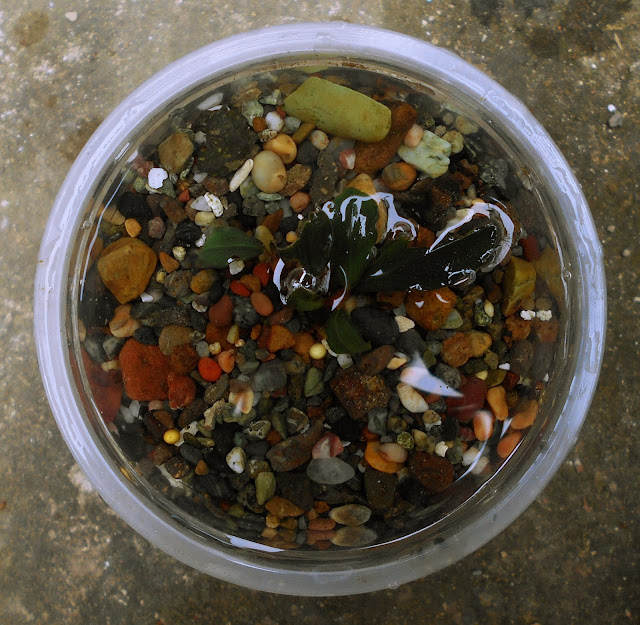A first stab at Bucephalandra
In a bid to rekindle the lost fire between myself and aquatic plants, I recently placed an order for some bucephalandras- a perfect choice I reckon, given my interest in both aroids and aquatic plants. Now, despite experience in maintaining a wide range of aquatics, admit I must that I have never yet tried my hands on any Bucephalandra. That changes today.
 |
| Bucephalandra 'S Blue' |
Now, I know I said 'aquatic plants' and all, but maybe I should establish at the onset that I intend to maintain the plants in an emersed state. I do have tanks, but I am not yet willing to take the full aquatic gardening plunge, so to speak. That will come much later. Potting up the plants is straightforward and done exactly with the same methods as outlined in a previous post about Cryptocoryne. But for the lazy, I only used repurposed containers with gravel beneath, topped by filter wool and overlaid with a layer of activated carbon, then topped again by filter wool.
The deepest layer constitutes aquarium gravel laced with balanced time-release fertilizers. The plants are loosely placed atop the gravel; one constant rule for aquatic aroids with creeping rhizomes is to never bury the storage organs, or rot may ensue. Finally, water is added.
That's it. Some set-ups from other keepers may be simpler (or more complicated), but this is the method that has worked the best for me- for crypts. Only time will tell if this will also work for the slow-growing bucephalandras.
I forgot to tell you that I also purchased an Anubias barteri 'Coffeefolia' for good measure. For the curious, the plants shown here are, from left to right, top row: A. barteri 'Coffeefolia', and B. 'Cherry'. Left to right, midrow: B. 'S Blue', B. 'Mini Hades', and B. 'Kedagang'. And finally, that's B. 'Lamandau Mini' in front of them all. All of these were placed inside a terrarium where they will spend the next days until fully acclimated, or until new growths have already appeared. Being stiffer-leaved than crypts, I am expecting the bucephalandras to fare well, if not better, under typical tropical garden conditions.
Then I'll buy more plants.







I have bucephalandra too and anubias. Bucephalandra seems to be harder to care for as im growing it in a slab of rock, slanted and make water flow through it and can be very tricky (unstable conditions might kill it). Anubias otherwise is easy, it propagates fast too if you cut the main growing point.
ReplyDeleteI dont grow them in soil, most of them grow hydroponically which I find best especially with osmocote as fertiilizer
Agree on the Bucephalandra being more difficult to take care of. I recently placed them in a spot where they are getting much more light with the soil drying out a bit than it does from their former spot and surprise! They seem to like it better. Still slow, though.
DeleteI had hardly made my Buces budge even if Im growing them in a "rheophytic" situation and emersed, as it is said to do well better emersed. Currently, Im having many types of Anubias (A. barteri nana, A. barteri golden nana, A. barteri round leaf, A. barteri coffeefolia, A. minima, A. congensis, A. nana petite, A. nana wavy) as they are growing really fast cuz I grow them under sunlight. I really don't know the proper condition for my buces even if Im growing them under sunlight with plenty nutrients form osmocote plus
DeleteThe buces that enter cultivation in the Philippines are mostly imports, which raises the probability that these were wild-collected. Hence, the difficulty. It would seem that these plants would require a few generations of captive propagation to properly adapt to most conditions. Watching even those videos of plants in nature and replicating these in a home setting still mostly yields disappointing results.
DeleteYou're right as I've read too that Bucephalandra wants cooler temps of 21-27 deg. C, which I cannot possibly achieve growing them emersed as the water temperature here reaches to 32 degrees even if its in shade and with just an hour or two of sunlight. Probably ill opt for Schismatoglottis prietoi, native in the country but I aint have one yet
DeleteI had a handful of buce die before my hands after cultivating them outdoors with a sliver of full sun sometimes but it seems like algae and fungi beats me even with cooler water. I tried again, this time indoors with LED. I had 2 sources of buce that I had bought from. It seems like some sellers still sell wild plants since it took a month from a source for the buce to make a new leaf. Meanwhile the other source--from Baguio, had grown a leaf in less than 5 days even from the stress it took during transport. Right now im sticking to the indoor solution as I had no fungal or algal (except for diatoms in the container's surface) issues
DeleteFortunately for me, I learned early on that I cannot keep buce underwater without flowing water- and that I gleaned from a fellow grower who tried his hand at these plants months before I decided to have one. If grown emersed, the algae problem is instantly eliminated, particularly if nutrient levels are low and the plants aren't getting a lot of light.
Delete